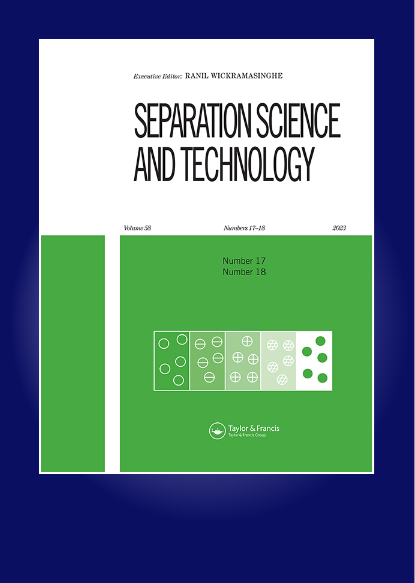酸浸-离子交换树脂吸附联合工艺对污泥中重金属的选择性提取:优化及性能评价
IF 2.3
4区 工程技术
Q3 CHEMISTRY, MULTIDISCIPLINARY
引用次数: 0
摘要
污水污泥(SS)中的重金属(HMs)是限制SS土地应用的主要障碍。尽管研究了酸浸法和阳离子交换树脂(CER)吸附法去除HMs的方法,但这两种方法都不能同时满足高效去除HMs和良好保存营养物质的需求。本文采用硫酸(H2SO4)和乙酸(AC)溶解SS中的HMs,然后进行CER吸附,选择性地从酸性渗滤液中提取HMs。添加5 mmol/L H2SO4时,Ni、Cu、Zn和Fe的最大浸出率分别为64.0%±2.7%、29.0%±3.7%、98.4%±4.1%和16.4%±0.3%。渗滤液中Fe对CER吸附HMs无明显抑制作用。与含硫脲基(R-SH)和羧基(R-COOH)的CER相比,含磺酸基(R-SO3H)的CER对酸性渗滤液中Ni、Cu和Zn的吸附效率更高。通过三角化模型评价,得出H2SO4与R-SO3H联合使用的最佳操作条件具有去除HM效率高、成本合理、能耗低等优点。本文章由计算机程序翻译,如有差异,请以英文原文为准。
Selective extraction of heavy metals from sewage sludge via combined process of acid leaching and ion exchange resins adsorption: Optimization and performance evaluation
ABSTRACT Heavy metals (HMs) in sewage sludge (SS) are major obstacles that limit the land application of SS. Although the removal of HMs with acid leaching and cation exchange resins (CER) adsorption has been investigated, neither process alone could meet the simultaneous demand for efficient HMs removal and good preservation of nutrients. In this report, sulfuric acid (H2SO4) and acetic acid (AC) were used to dissolve HMs from the SS, and subsequent CER adsorption was conducted to selectively extract the HMs from acid leachate. With the addition of 5 mmol/L H2SO4, the maximum leaching efficiency of Ni, Cu, Zn and Fe were 64.0%±2.7%, 29.0%±3.7%, 98.4%±4.1% and 16.4%±0.3%, respectively. No significant inhibition effect of Fe in the leachate on the HMs adsorption with CER has been observed. The CER with sulfonate groups (R-SO3H) showed higher Ni, Cu and Zn adsorption efficiency than the CER with thioureido groups (R-SH) and carboxylic groups (R-COOH) in the acid leachate. The optimal operation condition with a combined usage of H2SO4 and R-SO3H is characterized by the advantages of high HM removal efficiency, affordable cost, and low energy consumption through the evaluation with the triangulation model.
求助全文
通过发布文献求助,成功后即可免费获取论文全文。
去求助
来源期刊

Separation Science and Technology
工程技术-工程:化工
CiteScore
6.10
自引率
3.60%
发文量
131
审稿时长
5.7 months
期刊介绍:
This international journal deals with fundamental and applied aspects of separation processes related to a number of fields. A wide range of topics are covered in the journal including adsorption, membranes, extraction, distillation, absorption, centrifugation, crystallization, precipitation, reactive separations, hybrid processes, continuous separations, carbon capture, flocculation and magnetic separations. The journal focuses on state of the art preparative separations and theoretical contributions to the field of separation science. Applications include environmental, energy, water, and biotechnology. The journal does not publish analytical separation papers unless they contain new fundamental contributions to the field of separation science.
 求助内容:
求助内容: 应助结果提醒方式:
应助结果提醒方式:


